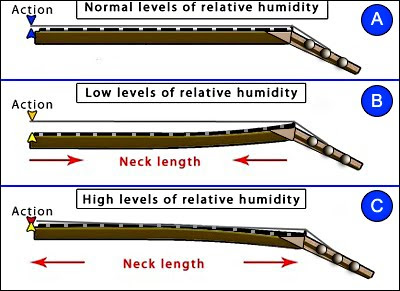Physics in bouzouki's life
Measuring humidity and temperature!
.

Dramatic changes of the relative humidity, can effect bouzouki's action and playability as shows at the drawing above. It would be also wised to keep your instrument away from direct exposure to air conditioner, fireplace, radiator, heat and sunlight (especially the summer).
.

How the relative humidity can effect action and playability
.
One of the first tools I bought, after receiving my Tsoulogiannis bouzouki, was a digital hygrometer (humidity/temperature reader).
It is very useful to control the relative humidity in the room where your instrument is being kept. Expensive classic instruments are kept in airtight cases with fully integrated hygrometer.
It is very useful to control the relative humidity in the room where your instrument is being kept. Expensive classic instruments are kept in airtight cases with fully integrated hygrometer.
The most suitable relative humidity for a bouzouki instrument accordingly to an article by the famous luthier Xristo Spourdalaki in klika (http://www.klika.gr) is from 47% to 57%.
I keep my instrument in a room with temperature fluctuating between 75 F- 78 F (24 C- 25.5 C) and relative humidity between 55%-58%
"Relative humidity is defined as the ratio of the partial pressure of water vapor (in a gaseous mixture of air and water vapor) to the saturated vapor pressure of water at a given temperature".
I keep my instrument in a room with temperature fluctuating between 75 F- 78 F (24 C- 25.5 C) and relative humidity between 55%-58%
"Relative humidity is defined as the ratio of the partial pressure of water vapor (in a gaseous mixture of air and water vapor) to the saturated vapor pressure of water at a given temperature".
In other words, relative humidity is the amount of water vapor in the air at a specific temperature compared to the maximum water vapor that the air is able to hold without it condensing, at that given temperature.
Relative humidity in hot summer weather, it also increases the apparent temperature to humans by hindering the evaporation of perspiration from the skin as the relative humidity rises. For example, according to the Heat Index, a relative humidity of 75% at 80°F (27°C) would feel like 83.574°F ±1.3 °F (28.652°C ±17. °C) at ~44% relative humidity.
Relative humidity in hot summer weather, it also increases the apparent temperature to humans by hindering the evaporation of perspiration from the skin as the relative humidity rises. For example, according to the Heat Index, a relative humidity of 75% at 80°F (27°C) would feel like 83.574°F ±1.3 °F (28.652°C ±17. °C) at ~44% relative humidity.
Dramatic changes of the relative humidity, can effect bouzouki's action and playability as shows at the drawing above. It would be also wised to keep your instrument away from direct exposure to air conditioner, fireplace, radiator, heat and sunlight (especially the summer).

Nice blog..
ReplyDeleteThanks for Sharing...
Humidity Meter, Controller, pH Controller, Meter, Temperature Logger, Controller